Is tagging important for SEO? A lot of SEO professionals will respond with a tentative, “It depends.”
Make no mistake – done incorrectly, tagging can actually have counterproductive impacts on your SEO efforts.
In this article, we will explore examples of the many ways that tag pages can be beneficial for SEO. We will also explore the technical SEO considerations and automation.
We will explore examples of tagging for SEO and how it’s not only used for search optimization. There are personalization, advertising, automation, analytics, and user experience benefits to tagging, as well.
What Is Tagging?
A tag is a keyword or term assigned to a piece of information to help describe what it is about and make it easy to locate.
Tagging is not a groundbreaking internet innovation, but an important concept of the modern web.
At the beginning of Web 2.0 when social bookmarking, image sharing, and social media sites exploded onto the scene, tagging became important.
More and more people began to upload vast amounts of information to the internet. A solution was needed to keep it organized.
People could simply create “tags” to categorize their content using keywords. As a result, databases could be quickly searched for content using these tags.
Take hashtags as an example from Twitter, where tagging uses a “hash” symbol, making it easy to quickly categorize content for discovery by new audiences.
What Are Good Tagging Examples For SEO?
Some SEO pros argue that tagging can be good for UX but bad for SEO.
It’s important to highlight that some of the most visited websites on the internet use tagging. Take Tiktok’s “Discover” tag block on their homepage, for example.
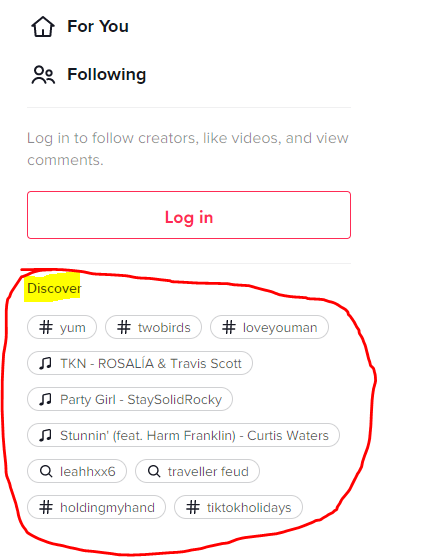 Screenshot from TikTok, November 2021
Screenshot from TikTok, November 2021Pinterest’s pins are another example. Pinterest users can categorize their pins with hashtags in the description.
Pinterest pins rank for 340k keywords on Google.ie alone, never mind the entire international keyword footprint for their curated user-generated tag pages.
 Screenshot from Ahrefs, November 2021
Screenshot from Ahrefs, November 2021And despite being called pins, they are unique URLs with content on them. In the eyes of search engines, they are handled the same way.
Google’s John Mueller confirmed this by explaining that there is no difference between category and tag pages. Both are “…another page that we could index or that we could use to pick up links to your articles.”
Is There A Difference Between Tagging & Topics?
Twitter is probably the best example to explain that there is a difference between tagging and topics.
Twitter introduced its “topics” in 2019 as another way to help people discover content.
Simply put, topics are clusters of related tags.
Take the hashtag “Friends” as an example.
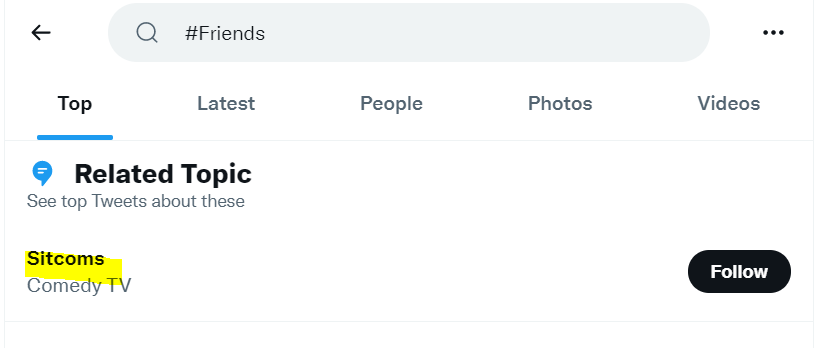 Screenshot from Twitter, November 2021
Screenshot from Twitter, November 2021When we think of Friends, we think of the TV show. And as shown below, this is exactly how Twitter has grouped it.
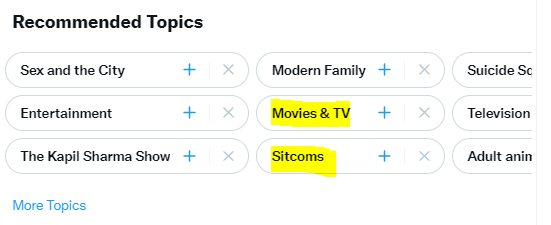 Screenshot from Twitter, November 2021
Screenshot from Twitter, November 2021Twitter has also clustered sitcoms under the umbrella topic of Entertainment.
And as shown below with Twitter’s topics picker, these can be highly personalized in the For You block.
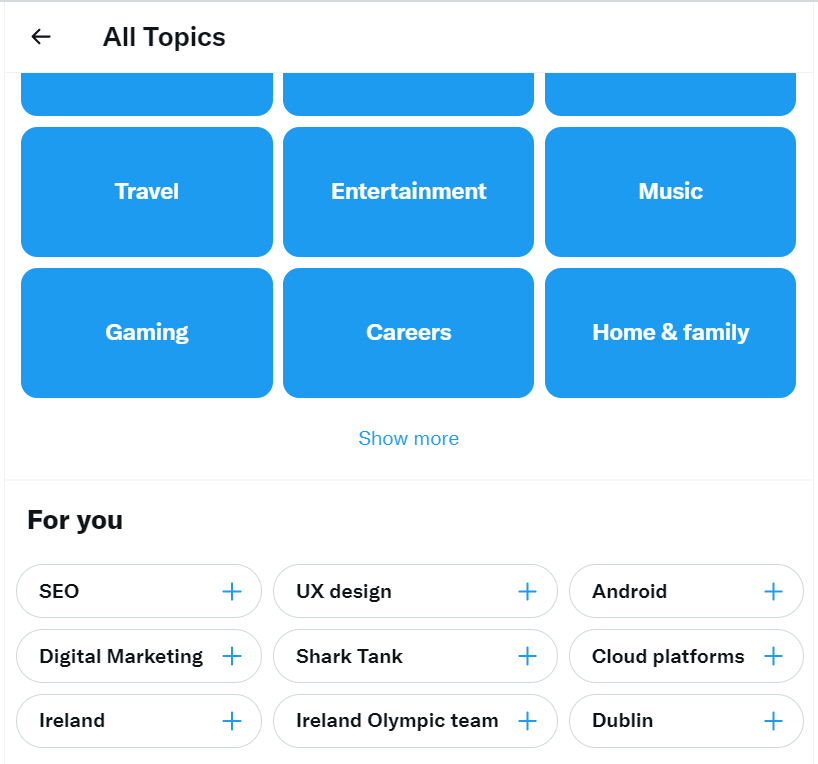 Screenshot from Twitter, November 2021
Screenshot from Twitter, November 2021The main difference between tagging and topics is that tagging is assigning a term to a piece of information.
However, topics are organizing those terms into their associated family, directly or indirectly.
What About Topics and Subtopics?
Topics can also have subtopics.
Subtopics are an expanded method of organizing sets of tags.
Take the LinkedIn homepage as an example.
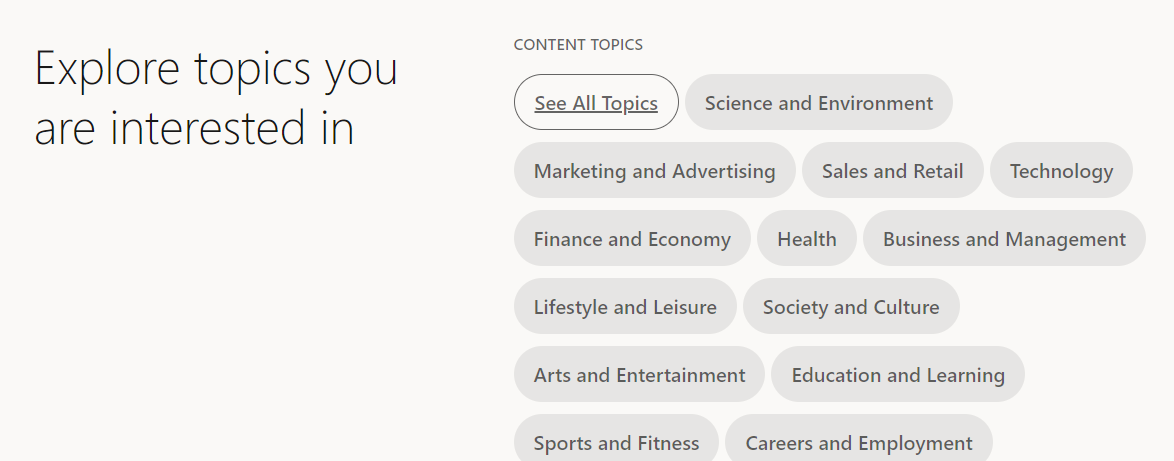 Screenshot from LinkedIn, November 2021
Screenshot from LinkedIn, November 2021We can see in the above image, there is an Arts and Entertainment topic.
And as a subtopic of entertainment, we also see TV and Radio:
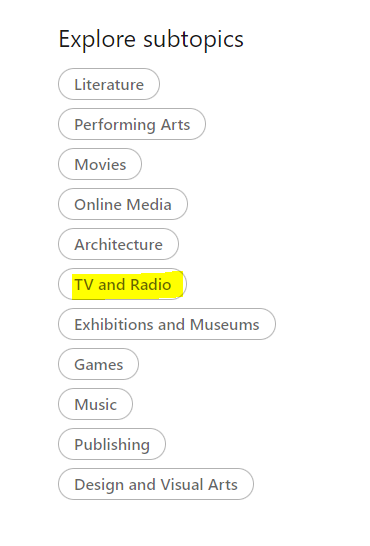 Screenshot from LinkedIn, November 2021
Screenshot from LinkedIn, November 2021Think of content tagging optimization as the category, sub-category optimization SEO tactic generally discussed in Ecommerce SEO.
Sticking with the entertainment niche to explain this concept further, the Netflix genre tagging is one of the best examples on the internet.
We will use familiar e-commerce SEO terminology to explain their movies genre set up for SEO.
Movies are the main category, kids movies are a subcategory of movies. Forgive the pun, but it’s a parent-child category relationship.
Whether these are defined as categories, content hubs, genres, pins, or hashtags, they are all still forms of tagging.
And done right, tagging can help with SEO.
What Are The Benefits Of Tagging For SEO?
The benefit of tagging for SEO is search engine visibility. But tagging is not just for SEO.
It can help feed personalization, provide advertising intelligence, and guide a more granular level of analytics insights.
Search Engine Visibility
Using the Netflix genre example, and passing it through a popular keyword visibility tool, we can see that tagging is beneficial for their keyword visibility on Google.
 Screenshot from Ahrefs, November 2021
Screenshot from Ahrefs, November 2021Their genre tagging as shown above allows them to rank on Google in the top 3 for their generics such as movies, comedy movies, and psychological thrillers.
Conversion
When we think product-led SEO, Netflix genre tag pages ranking on search is great awareness for their products.
But driving conversions for their products from search is even better.
On each of Netflix’s genre tag pages, there is a call to action as shown below.
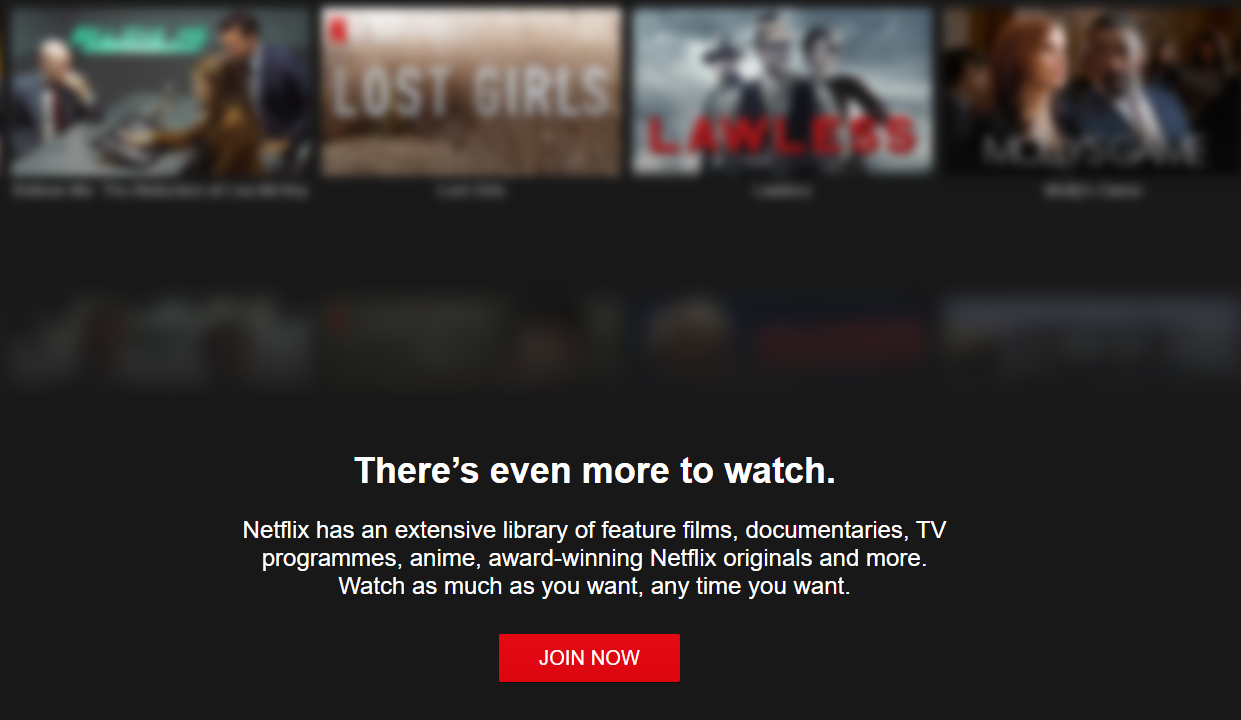 Screenshot from Netflix, November 2021
Screenshot from Netflix, November 2021When designing tag detail pages or even a tagging infrastructure for a website, they don’t have to just be another page for Google to index and rank.
They can also be a great way to drive more customers from search to your product.
Personalization
Tagging can feed personalization. YouTube is a great example of this.
Shown below are YouTube’s tags underneath their homepage search bar, personalized based on the user’s searches and video history.
 Screenshot from YouTube, November 2021
Screenshot from YouTube, November 2021Google Discover is another great example of tagging to feed personalization.
Google Discover uses the topic layer to understand relationships between people places and things, as well as facts about them.
“The Topic Layer is built by analyzing all the content that exists on the web for a given topic and develops hundreds and thousands of subtopics.
For these subtopics, we can identify the most relevant articles and videos—the ones that have shown themselves to be evergreen and continually useful, as well as fresh content on the topic.
We then look at patterns to understand how these subtopics relate to each other, so we can more intelligently surface the type of content you might want to explore next.”
Advertising
Tagging can be useful for contextual advertising systems to display ads related to that topic.
It can also help in the forms of “hidden tags,” whereby the system would not show ads to a user on a sensitive topic.
Analytics
Tagging can also be helpful for understanding patterns within a data set. Take the example of tagging news articles. Audience analytics tools such as Chartbeat, Parse.ly, or Google’s News Consumer Insights may show you the most engaging articles.
But so what? What did we learn?
Questions such as, “What should we do more of?” and “What should we do less of?” can be better answered by giving articles a better DNA.
For example, tagging article types by long reads or news updates by topic or subtopic can help provide deeper insights into content performance.
This can enhance the intelligence of your analytics data for smarter business and editorial decisions.
Publisher SEO And Tagging
Publishers have some of the largest content libraries on the internet. Some publishers’ content goes back as far as 1851 online.
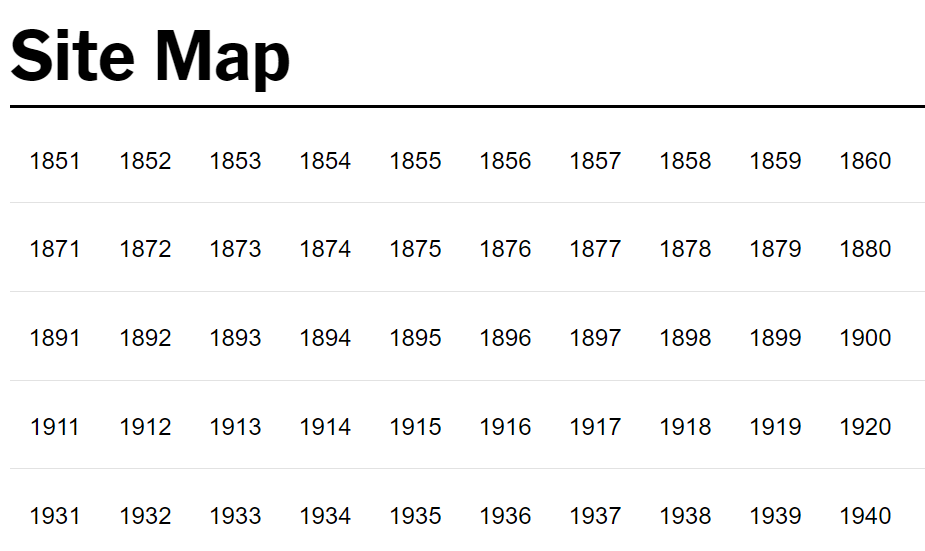 Screenshot from New York Times, November 2021
Screenshot from New York Times, November 2021Website Architecture Optimisation
The challenge with most publishers is that each day there is a vast amount of content published.
And generally, most news publishers are not set up to handle this amount of content with their standard taxonomy consisting of a homepage and content categories.
Take Independent.ie, a national Irish news publisher that I work with.
Shown below is a pie chart comparing the total crawled pages (254,439) versus total valid pages available at the time in the website’s article XML sitemaps (1,494,453).
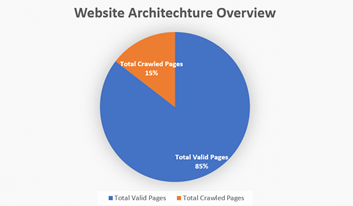 Image created by author, November 2021
Image created by author, November 2021As visualized above, orphaned content was a big issue. And as orphaned pages do not receive much attention from Googlebot, fixing the website’s architecture was one of the first technical SEO issues that needed to be addressed.
A quick fix way to tackle these issues is through the implementation of HTML sitemaps or otherwise known in this niche as content archives.
These content archives help flatten the internal linking architecture of deeper pages, especially on these large websites.
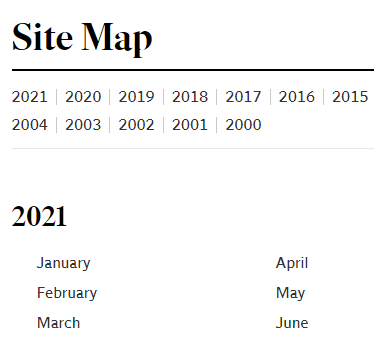 Screenshot from Independent.ie, November 2021
Screenshot from Independent.ie, November 2021In the Independent.ie example pictured above and detailed below, in 3 clicks, a user and search engine can discover 20 years of content from the root.
Example:
Root /
Click 1 – /html-sitemap-article-index/ (Article archive overview)
Click 2 – https://www.independent.ie/html-sitemap-article-index/2000-01/ (Article archive by year and month)
Click 3 – https://www.independent.ie/html-sitemap-article-index/2000-01/1/ (Article archive by year, month and day of publishing)
Keyword Longevity
For most publishers, the majority of their search traffic will come from both the top stories and regular organic listings.
When a topic is newsworthy, Google with its Query Deserves Freshness (QDF) algorithm will trigger the top stories carousel and display the most recent news on a topic in its organic results.
Newsworthy queries include:
- Recurring news event queries (e.g., elections, sports events, TV shows, conferences, etc.).
- Current information queries about people, places, or things.
However, after the fact, when that query is no longer trending, Google’s SERPs return mostly informational results for these queries.
This is when tag pages for news sites can rank very well after the fact and improve keyword longevity.
Example: Kate Middleton.
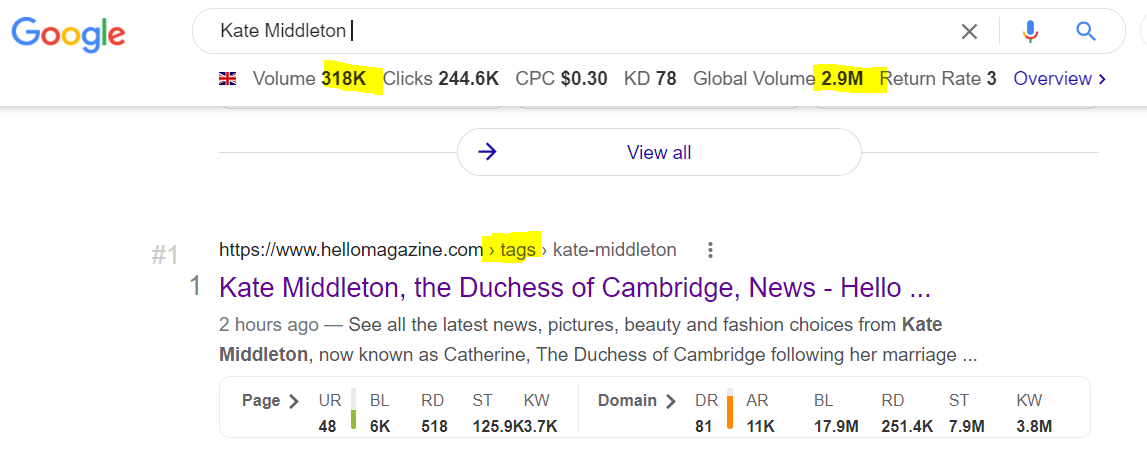 Screenshot from Google, with SEO Toolbar by Ahrefs, November 2021
Screenshot from Google, with SEO Toolbar by Ahrefs, November 2021And in November 2021, when the keyword Kate Middleton on Google has approximately 318,000 average searches per month in the UK alone, Hellomagazine’s tag page ranks #1.
Does Tagging Really Work For Publisher SEO?
Independent.ie recently implemented tagging as an SEO experiment and almost overnight, improved total search impressions for its tag overview pages.
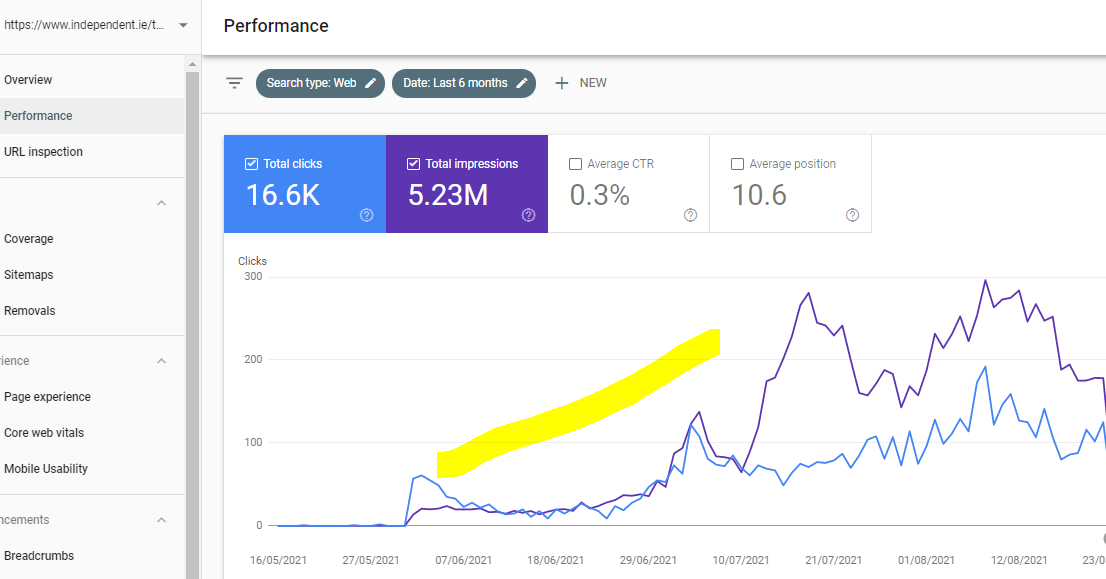 Screenshot from Google Search Console, November 2021
Screenshot from Google Search Console, November 2021Shown above is the increase from zero to 16,000 additional passive clicks from search for a very minimal selected set of tag pages set up under the tag overview page.
Keyword Cannibalization
The motivation for the experiment from a business perspective was obviously additional pageviews from search.
However, from a technical SEO perspective, keyword cannibalization was on the priority list.
To tackle keyword cannibalization, the strategy is to consolidate competing URLs to a singular URL for that topic, generally using topic clusters. However, this strategy can be problematic for news sites.
Keywords in the headline of a news article are one of the strongest ranking factors for Google News and top stories.
In editorial production, especially on a large news site, there may be several stories published on a singular topic on any given day.
This can cause multiple stories to compete with each other; not noticeably on the day, as freshness plays a big role in top stories ranking positions. But the issue here for publishers is after the fact.
When news on a topic is no longer “trending,” Google tends to flip the SERP from ranking news article detail pages to ranking publisher tag detail pages.
When publishers have tag pages set up for SEO, these pages can act as topic clusters.
And as demonstrated above with the Kate Middleton example, instead of multiple articles competing against each other, with the older article generally being demoted in SERPS, tag pages can help publishers rank for topics in the organic listings.
Article Recirculation
For many news publishers, the homepage is the shopfront for the latest, breaking, and the best news of the day. However, publishers rarely think about the article detail pages as the main shopfront.
This is a shame, as most publishers get a large percentage of their traffic from both search and social. For these channels, article detail pages are what the reader consumes as their first touchpoint with the brand.
Tagging can help inform article recirculation widgets to help both pass internal link equity into other related or published articles, and help reduce bounce rate by giving the reader the option to read more on a topic when they come from these channels.
Independent.ie Katie Taylor article detail page example:
 Screenshot by Author, December 2021
Screenshot by Author, December 2021In fact, for Independent.ie, the biggest benefit to traffic was not from search alone. Tagging improved article recirculation traffic.
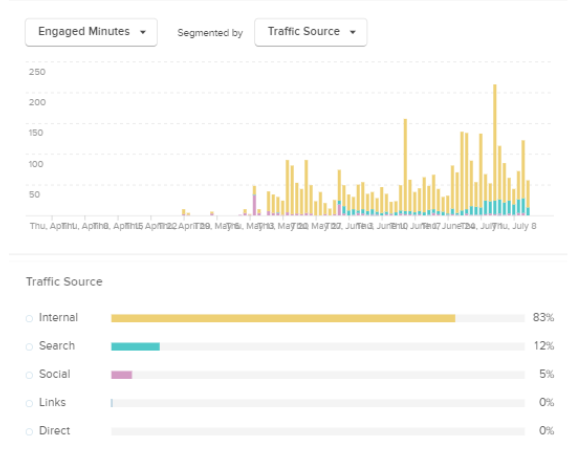 Screenshot by Author, November 2021
Screenshot by Author, November 2021Topical Authority
How does Google determine who is an authority on a topic?
In a recent SEO webinar for publishers, Danny Sullivan answered this question:
“If your site has a history of publishing authoritative content for a topic, we can see you as an authority in that area.”
Does Google use tag pages to determine whether you should rank in the top stories for a topic?
Possibly not. However, we do know that Google uses links as a signal of authority.
And using the Kate Middleton example above from Hello Magazine, looking at that page’s anchor text, there are 118 referring domains pointing to exact match keyword anchor text links to that page.
 Screenshot by author from Ahrefs, November 2021
Screenshot by author from Ahrefs, November 2021This possibly occurs when a paragraph is copied into a WYSIWYG content editor in visual mode as opposed to text mode, the link to the tag overview page is also be copied.
 Screenshot by Author from Ahrefs, November 2021
Screenshot by Author from Ahrefs, November 2021In this light, tagging can also prove to be an automated link magnet for publishers.
Who wouldn’t want a lever like that in their off-page SEO strategy?
What Is The Problem With Tagging And SEO?
The biggest issue with tagging and SEO is the crawl budget concern.
For example, if we examine Google’s documentation on crawl budget for large websites, the first bit of advice Google provides is to “consolidate duplicate content.”
How Does Duplicate Content Occur Within Tagging?
Duplicate content can occur with tag pages are for misspellings i.e. “Googlle” instead of Google causing two duplicate tag pages.
example.com/tag/google/
example.com/tag/googlle/
The other common example happens with synonyms, i.e.: Joe Biden, Biden, US President Joe Biden, US President Joseph Robinette Biden Jr., 46th U.S. President.
The following pages would be created:
example.com/tag/joe-biden/
example.com/tag/biden/
example.com/tag/us-president-joe-biden/
example.com/tag/us-president-joseph-robinette-biden-jr/
example.com/tag/us-president-46/
All of these synonyms are valid in their own right but can cause a spiral of duplicate tags.
And for every tag, each possible synonym was created and left up to user interpretation of what the tag should be called.
On large websites, this could cause issues with crawl budget and keyword cannibalization.
Thin Content Is Also A Concern With Tagging
Sometimes tags can be created by a user, where there is only one result.
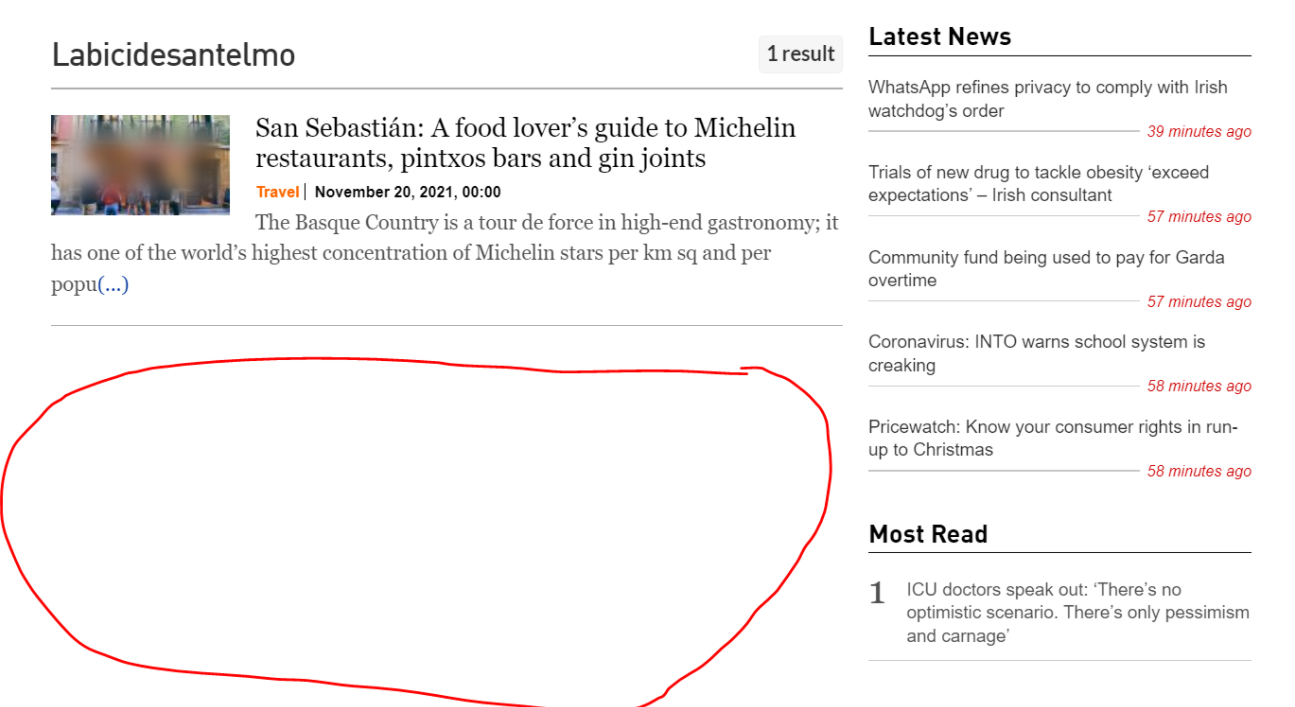 Screenshot from Irishtimes.com, November 2021
Screenshot from Irishtimes.com, November 2021However, if the competition is low enough, as is with this made-up word, these single-result pages will still index and rank.
It may be nothing too concerning to worry about.
However, if the crawl budget is an issue, and the more important articles are not being indexed fast enough as Google is spending too much time on thin, low-value pages, then this is something to audit.
Technical SEO Best Practices For Tagging
There is little difference between the technical SEO best practices of tagging and what is normally considered best practice.
URL Structure
“Google Search does not specifically differentiate and treat differently category pages or filter pages or search pages or tag pages from other pages. “
Technically, each of the following URL structures could work for tag pages, assuming there is only one URL variation for a tag:
example.com/tag/{tag-name}
example.com/category/{tag-name}
example.com/search/{tage-name}
example.com/{tag-name}
Internal Linking Automation
Internal linking can be automated with tag pages. How to do this is to have the system automatically link to the tag overview page when the first mention of that word is used within the copy.
See the following snippet from a Guardian article on Liverpool for reference.
It systematically links to its Liverpool tag overview page upon the first mention, but not every mention of the word.
 Screenshot from The Guardian, November 2021
Screenshot from The Guardian, November 2021Having every mention of the word linked as seen in the following snippet from a fantasy football article is overkill, in my opinion.
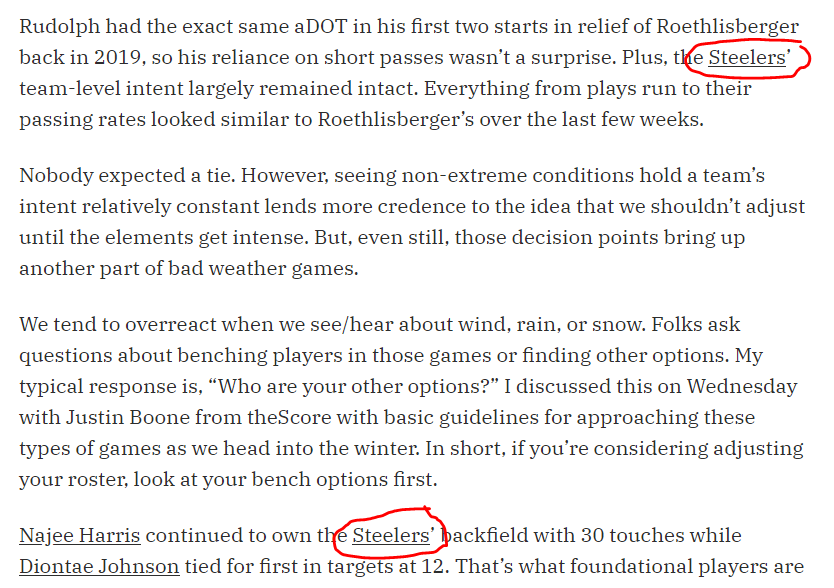 Screenshot from 4for4.com, November 2021
Screenshot from 4for4.com, November 2021The other important element here in terms of internal linking is to take advantage of topic HTML sitemaps.
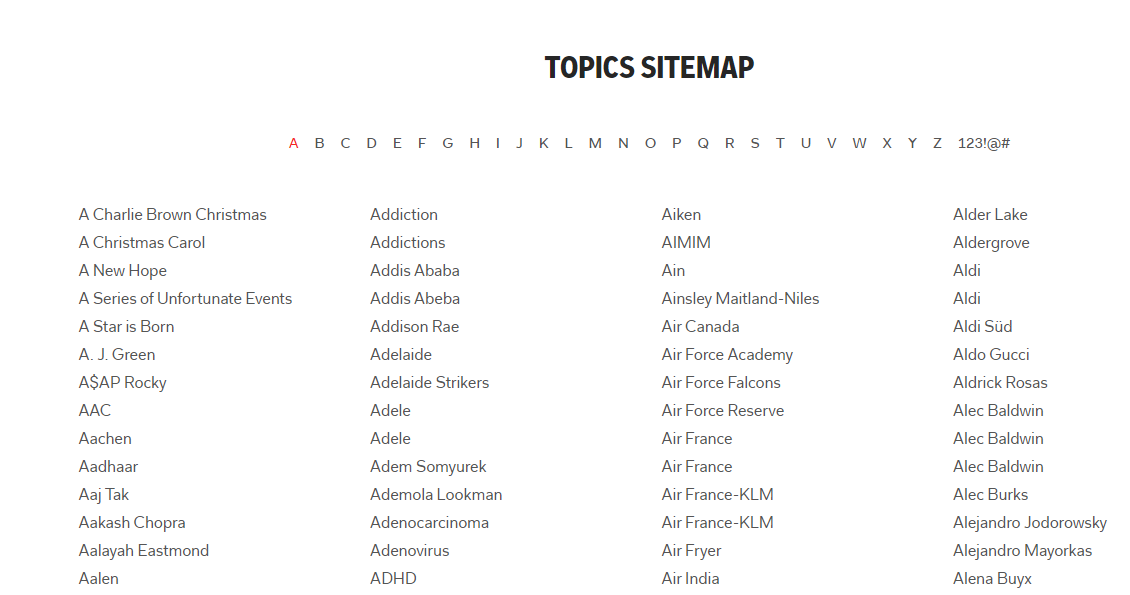 Screenshot by author, November 2021
Screenshot by author, November 2021Examples:
- https://www.theguardian.com/index/subjects/a.
- https://flipboard.com/sitemap/topics.
- https://hbr.org/topics.
- https://www.webmd.com/a-to-z-guides/health-topics.
- https://www.artofmanliness.com/all-topics/.
These sitemaps will provide an additional link to each and every topic created on the website, helping to reduce the possibility of tag pages becoming orphaned.
For scalability, using an organizational method of alphanumerical pages as shown with all of the above examples can help reduce the reliance on pagination.
HTML sitemaps can also be used within a website to improve the internal linking architecture.
Take the Guardian’s tag organization for its content related to the various football teams and leagues, https://www.theguardian.com/football/teams, for example.
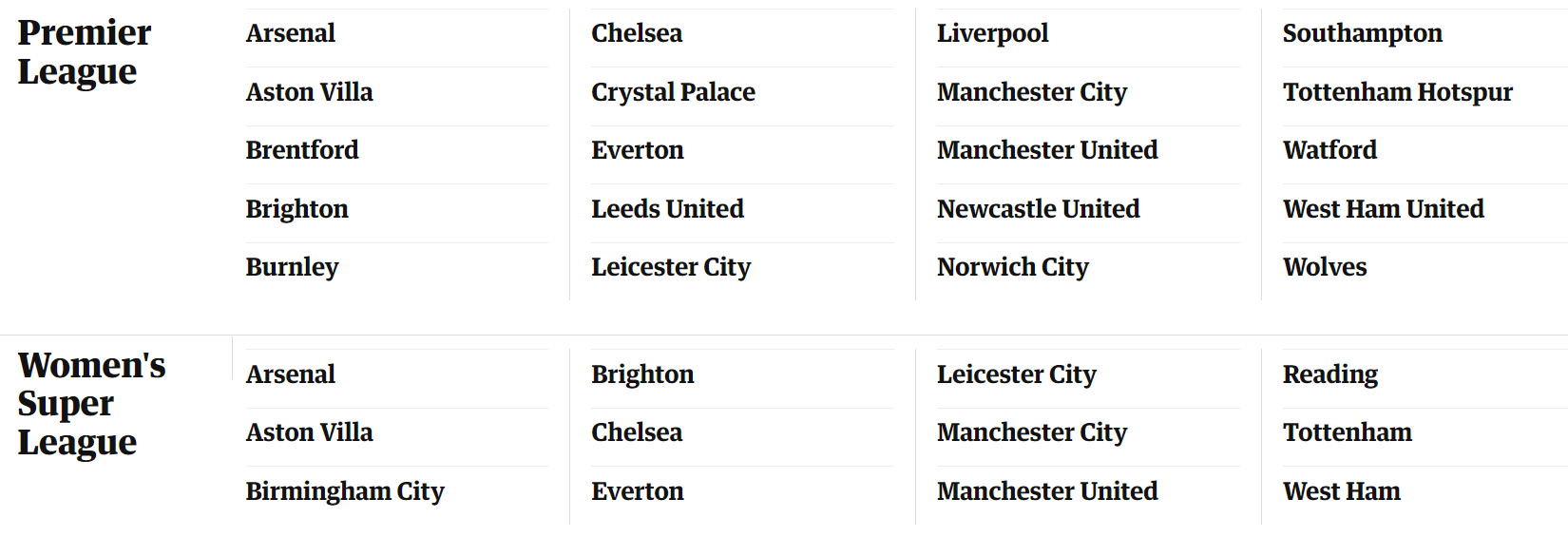 Screenshot from The Guardian, November 2021
Screenshot from The Guardian, November 2021HTML sitemaps for tags don’t have to be presented as a boring list of links.
https://www.wellandgood.com/all-topics/ is a great example of using images to make it more enticing to the end-user.
You could even try connecting section pages with topics, such as we can see with https://www.sciencenews.org/topics.
 Screenshot from Science News, November 2021
Screenshot from Science News, November 2021And https://www.parents.com/parenting/.
 Screenshot from Parents.com, November 2021
Screenshot from Parents.com, November 2021Information architecture doesn’t have to be a snore, and the majority of publishers can do a lot better with their website’s taxonomy.
Tagging can be a publisher’s secret weapon for this challenge.
Tagging Page Structure for SEO
- H1 = Name of Tag.
- H2 = Article Headlines.
- Copy and internal links.
 Screenshot from Hellomagazine.com, November 2021
Screenshot from Hellomagazine.com, November 2021When looking for page structure best practice, the Kate Middleton tag page on HelloMagazine.com is again a great example.
It is also a great reference for how SEO’s working for a news publisher can do on-page optimization without having to rely on news articles that may have editorial red tape.
Should Tag Pages Be Indexed?
If a tag page provides a unique value, it should be indexed.
There are scenarios where a certain tag page may be better served for the health of the website not to be indexed.
In those cases, it may be best for that tag page to be deleted, or instructions given to search engines not to crawl or to canonicalize to another URL.
A tag content audit on existing tag pages is a very valuable exercise to carry out to determine whether a tag page should be indexed.
Assuming that work has been done and low-value tag pages have been handled, tag pages should have a separate XML sitemap and be submitted to Google Search Console.
Both to monitor their performance on search results as well as their index coverage.
To help Google discover and crawl all tag pages as well as troubleshoot indexing problems, separating these out into their own XML sitemap makes this easier.
Tagging And Entity SEO
For SEO, the biggest benefit of tag pages on search engine visibility is for ranking for news queries that are no longer trending. Most queries for news are the entities found within the stories.
These should provide insights into what could be tagged from a story.
For example, using a semantic text analysis tool such as Dandelion, we can extract these entities for this SEO news article Twitter cancels AMP.
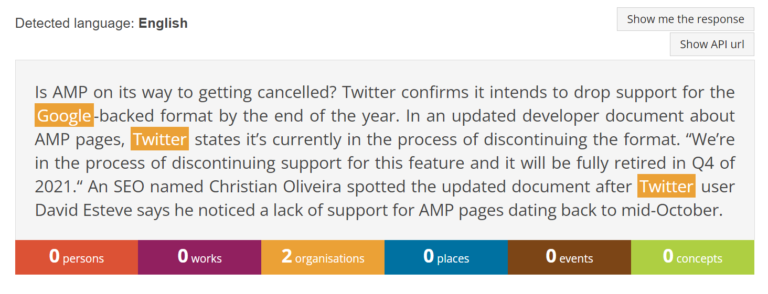 Screenshot from Dandelion, November 2021
Screenshot from Dandelion, November 2021The tool linked below is free to demo and will show all of the entities found within the text.
https://dandelion.eu/semantic-text/entity-extraction-demo/
By default, it will show all entities found. It will also show the associated Wikipedia data. When creating tag pages, all of the information is there to help create the copy.
This can be a great timesaver for on-page optimization of tag pages.
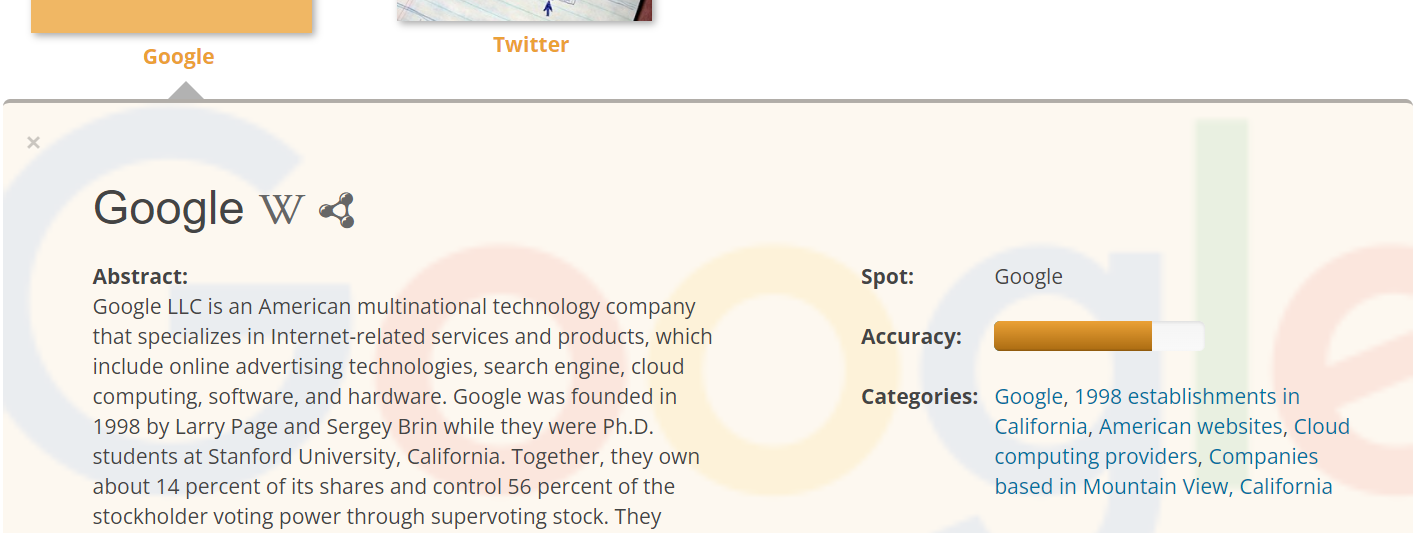 Screenshot from Dandelion, November 2021
Screenshot from Dandelion, November 2021Entities Are The Keywords
Another benefit of tagging entities is that they are generally the most searched keyword.
Take for example the following headline: Biden Meets With Canada’s Trudeau and Mexico’s López Obrador.
Typically, the full name of the person the story is about will generate the greatest search volume.
If we run this through the dandelion entity extractor, we get the following:
 Screenshot taken by Author on Dandelion.eu, November 2021
Screenshot taken by Author on Dandelion.eu, November 2021Running all of this data through a keyword tool to check search volume, we see that notable people’s full names get the greatest amount of search traffic.
 Screenshot from Ahrefs, November 2021
Screenshot from Ahrefs, November 2021It makes the most sense to create a tag page based on that logic.
Combining text entity extraction data with search data can help inform tag creation recommendations. Therefore, it makes sense to equip your editorial teams with the data on the best tag name synonym to use for SEO.
Tagging Automation
The SEO headline or (title tag) is one of the most important ranking factors for the top stories carousel.
Taking inspiration from Axel Springer’s tech team on generating SEO titles for news based on NLP modeling, tagging could also help with the automation of SEO titles.
Using their suggested logic, you could build internal editorial production tools based on semantic text analysis APIs to extract the entities. Combine this with data from keyword search volume APIs or the Google Search Console API.
Now you have a tool to help your editorial teams make smarter SEO decisions on what to tag within an article and what keyword to use within a headline for SEO.
Is Automated Or Manual Tagging Better?
Manual tagging of articles allows for more control of how many tags get published, as well as tag management such as tag naming and organization.
The problem with manual tagging is that it is not scalable and adds additional editorial workflow. Text analysis tools can help with tagging automation.
There are even publisher tag management services such as Open Callis, which will analyze the text and automatically add tags to articles.
This level of automation can offer great scale and help reduce editorial workflow for publishers.
However, this approach can be problematic for SEO as we discussed above with crawl budget and content quality optimization.
For SEO, as well as users, there is a middle ground.
Text tagging tools and search data APIs can help automate insights for tag discovery and selection. But tag management should have editorial and SEO control for better optimization.
Final Thoughts
Tagging is an underlying mechanism of the modern web, leveraged by tech giants such as Twitter and Google to aid their personalization algorithms.
Even so, tagging can be a hindrance if not integrated with technical SEO and content quality best practices.
Yet when done correctly, tagging for SEO can improve organic optimization efforts with low effort high impact results for publisher sites.
More Resources:
- Google Discusses Impact of Tags on Rankings
- Advanced Technical SEO: A Complete Guide
- 5 Critical SEO Considerations When Optimizing News Websites
Featured image: Shutterstock/VectorMine





